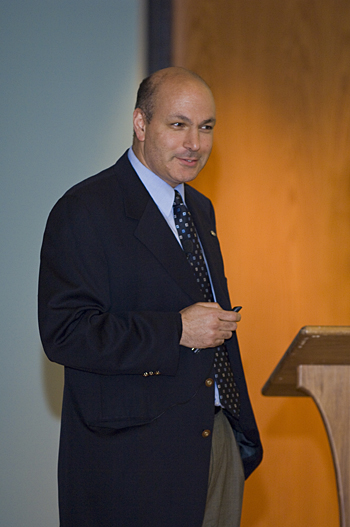
These “awakening” or thawing ice sheets will affect the world, from raising sea levels and threatening the existence of polar bears, to expanding maritime commerce and impacting national security, Abdalati noted.
One of the world's pre-eminent experts in the study of climate change, Abdalati provided evidence that the polar ice sheets are shrinking, drawing on data yielded by some 14 different scientific models used for predicting climate, to striking images of Greenland's and Antarctica's ice cover taken by NASA satellites.
The presentation was the latest installment in UD's William S. Carlson International Polar Year Events--a series of public programs named after UD's president from 1946-50 who conducted research in the Arctic. The lecture also was Webcast and simulcast to UD's island in the virtual world of Second Life.
Abdalati said he “fell in love with NASA” as a youngster, after watching the lunar landings. Today, he leads a group of scientists who monitor the planet's changing ice cover using satellites and other airborne instruments. He also is a veteran of nine field expeditions to the Greenland Ice Sheet.
“It's nature in its most austere form,” Abdalati said, showing a slide of a helicopter hovering along the edge of the Antarctic ice shelf towering taller than a football field above the waterline. “Does it matter that a place like this is changing?” he asked.
It does when 23 feet of sea-level rise is contained in the Greenland ice sheet, and 200 feet of sea-level rise is contained in the Antarctic, and this ice affects world climate and a whole host of other issues, he went on to explain.While Abdalati says the polar ice sheets “won't go tomorrow,” how much sea level rises in the future and how well we are prepared for it has huge social, political and economic implications for the world.
The impact of a one-meter (3.2 foot) rise in sea level in the world's oceans would amount to the inundation of 2.2 million square miles of coastline around the globe, the equivalent of one-quarter of the continental United States. It would affect 45 million people and cost a trillion dollars, Abdalati said.
Tools such as ice-penetrating radar and NASA's ICESat satellite have revealed that the Greenland Ice Sheet has a “weakened underbelly,” eroded by meltwater from thawing ice on the surface.
Since 1979, sea ice has been shrinking by about 8 percent per decade, Abdalati said. Every summer, sea ice thaws until it reaches a summer minimum. Then nature “presses a re-set button,” and the sea ice grows back in winter, he noted. However, the thick, old ice no longer exists in many places, leaving much thinner ice, more vulnerable to melting.
In 2007, scientists were stunned by the 23 percent reduction in sea ice that occurred from 2005-07. In 2007, a 76-year-old farmer from Minnesota navigated the largely ice-free Northwest Passage in a sailboat, he noted.
An ice-free Arctic Ocean has both negative and positive implications, Abdalati noted, providing the means for moving goods from Asia to Europe more quickly, and reducing the need to use the Suez Canal, not to mention increasing access to the Arctic's tremendous economic resources.
“With an ice-free Arctic--more heat is absorbed by the planet,” he said, which has huge implications for climate patterns. “Throughout recorded history, we've counted on this ice being there.”Besides the plight of the polar bears, whose numbers are diminishing, a warmer Arctic means melting permafrost.
As this frozen ground melts, it releases methane, a strong greenhouse gas. Melting permafrost already is costing Alaska some $35 million per year, where homes, highways and other infrastructure are affected by the sinking ground.
“Climatologically, we're in unfamiliar territory,” Abdalati noted. “The effectiveness of society's response depends on how big the changes are, how fast they come and how fast our ability will be to anticipate the changes.”
For information on UD's polar research and outreach activities, visit [www.udel.edu/research/polar].
Photos by Jon Cox and Debbie Jeffers
Link to article: http://www.udel.edu/PR/UDaily/2008/apr/giants041608.html







No comments:
Post a Comment